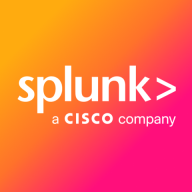

Splunk Enterprise Security and Google Chronicle Suite compete in the security information and event management (SIEM) category. Google Chronicle Suite seems to have an upper hand due to its superior cloud integration and scalability.
Features: Splunk Enterprise Security's key features include advanced threat detection, data visualization, and comprehensive security posture insights. It excels in analytics and offers deep integration capabilities. Google Chronicle Suite highlights include seamless integration with Google services such as VirusTotal and AI capabilities for anomaly detection, providing clean dashboards and user experience with its advanced threat intelligence tools.
Room for Improvement: Splunk Enterprise Security could improve its deployment model, which requires considerable setup and technical know-how. Enhancing user-friendly onboarding processes may add value. Google Chronicle Suite could enhance its support and integration with non-Google cloud platforms, addressing broader enterprise needs and potentially expanding its market reach.
Ease of Deployment and Customer Service: Splunk's deployment demands more setup effort but offers robust support and in-depth guidance. Google Chronicle Suite provides a straightforward deployment process directly in the cloud with seamless customer support, prioritizing ease of use and less complex initial engagement.
Pricing and ROI: Splunk involves higher upfront costs due to its extensive feature set, but it offers significant ROI through enhanced security capabilities. Google Chronicle Suite, however, presents a more cost-effective entry point with its scalable, cloud-based infrastructure, promising quick ROI for cloud-centric strategies.
Splunk's cost is justified for large environments with extensive assets.
We are a critical project for them at this moment, and they provide excellent service.
They are slow, and the initial responses often require more information rather than providing helpful solutions.
The technical support I’ve received is rated an eight out of ten.
If you want to write your own correlation rules, it is very difficult to do, and you need Splunk's support to write new correlation rules for the SIEM tool.
The technical support for Splunk met my expectations.
Google Chronicle Suite is very scalable, being a cloud-based solution.
I rate the scalability of Google Chronicle Suite as ten out of ten.
Chronicle Suite is fully scalable with a rating of seven or eight out of ten in scalability.
It is easy to scale.
They struggle a bit with pure virtual environments, but in terms of how much they can handle, it is pretty good.
I rate the stability of Google Chronicle Suite as a nine, as I have not encountered any stability issues.
It provides a stable environment but needs to integrate with ITSM platforms to achieve better visibility.
It is very stable.
The graphical user interface could be improved to enhance user experience.
The UI is the primary challenge in need of improvement.
The functionalities for parsing and including feeds need improvement.
Splunk Enterprise Security would benefit from a more robust rule engine to reduce false positives.
What Splunk could do better is to create an API to the standard SIEM tools, such as Microsoft Sentinel.
Data retention can be better. If we want to look at the data for five months or six months, that is not available to us. We only have a history of 20 or 30 days.
It's neither expensive nor cheap, and I believe it is a justified price for the features offered.
I experience Chronicle as less expensive and less complicated than Azure.
Our license is based on the size of the company with an all-you-can-eat model, considering storage capabilities per day.
The platform requires significant financial investment and resources, making it expensive despite its comprehensive features.
I saw clients spend two million dollars a year just feeding data into the Splunk solution.
Splunk is priced higher than other solutions.
The threat intelligence, especially continuous IOC feeds, is a standout feature.
They also combine their source solution into one product, allowing for out-of-the-box playbook creation and incident response.
The automated response feature allows for immediate actions like isolating infected machines or blocking malicious IP addresses.
This capability is useful for performance monitoring and issue identification.
They have approximately 50,000 predefined correlation rules.
Splunk Enterprise Security's most valuable features are its stability and the robust Splunk Search Processing Language.


Organizations primarily leverage Google Chronicle Suite for centralized log management, threat intelligence, and endpoint security, addressing MDR requirements with continuous monitoring.
Google Chronicle Suite supports storage, security, and alert checking. Utilizing log information to generate alerts and integration with search engines, it monitors network and login issues. It is a choice for consultants on client projects, and partners handle its global resale and implementation.
What are the key features of Google Chronicle Suite?Industries employ Google Chronicle Suite for its robust security measures and log management. It is especially vital for IT, finance, healthcare, and any sector needing stringent security and compliance. Consultants find it essential for tailoring security protocols in client projects, while partners ensure seamless implementation across regions.
Splunk Enterprise Security is widely used for security operations, including threat detection, incident response, and log monitoring. It centralizes log management, offers security analytics, and ensures compliance, enhancing the overall security posture of organizations.
Companies leverage Splunk Enterprise Security to monitor endpoints, networks, and users, detecting anomalies, brute force attacks, and unauthorized access. They use it for fraud detection, machine learning, and real-time alerts within their SOCs. The platform enhances visibility and correlates data from multiple sources to identify security threats efficiently. Key features include comprehensive dashboards, excellent reporting capabilities, robust log aggregation, and flexible data ingestion. Users appreciate its SIEM capabilities, threat intelligence, risk-based alerting, and correlation searches. Highly scalable and stable, it suits multi-cloud environments, reducing alert volumes and speeding up investigations.
What are the key features?Splunk Enterprise Security is implemented across industries like finance, healthcare, and retail. Financial institutions use it for fraud detection and compliance, while healthcare organizations leverage its capabilities to safeguard patient data. Retailers deploy it to protect customer information and ensure secure transactions.
We monitor all Security Information and Event Management (SIEM) reviews to prevent fraudulent reviews and keep review quality high. We do not post reviews by company employees or direct competitors. We validate each review for authenticity via cross-reference with LinkedIn, and personal follow-up with the reviewer when necessary.